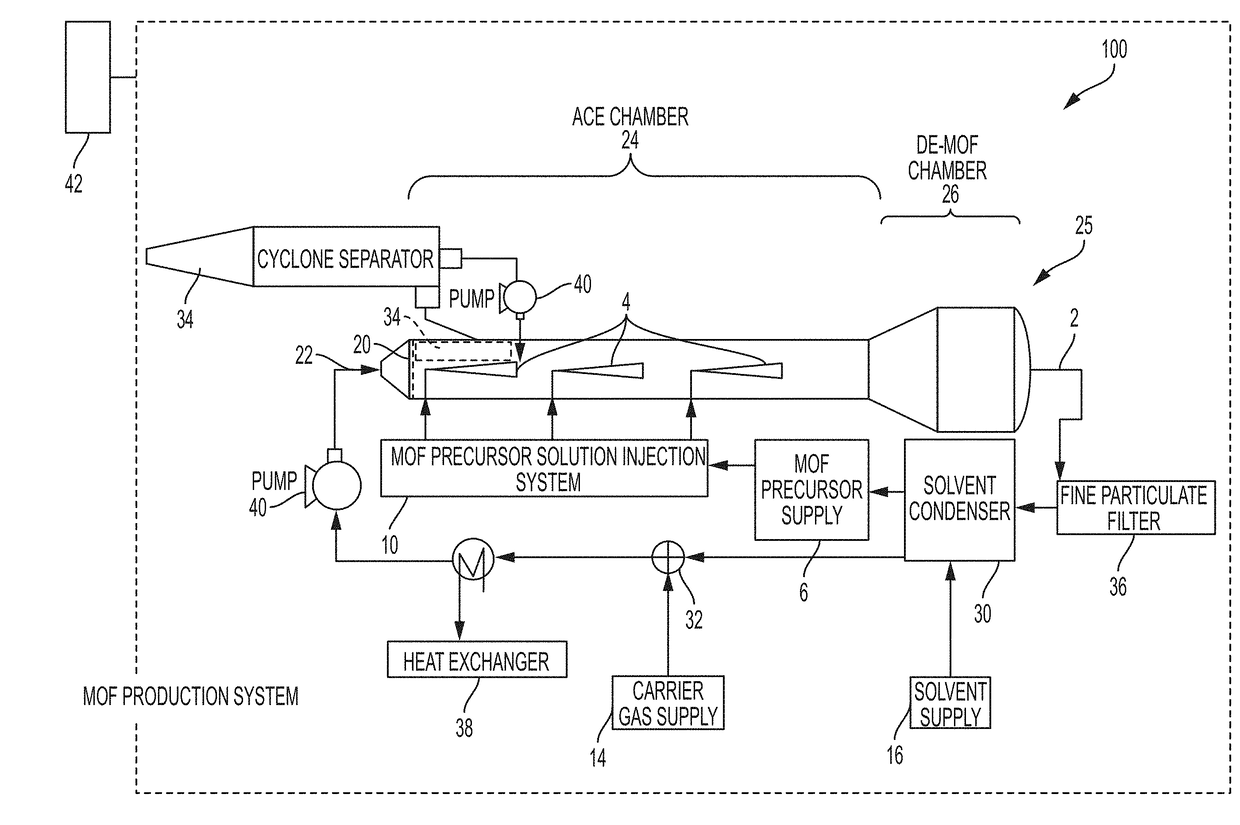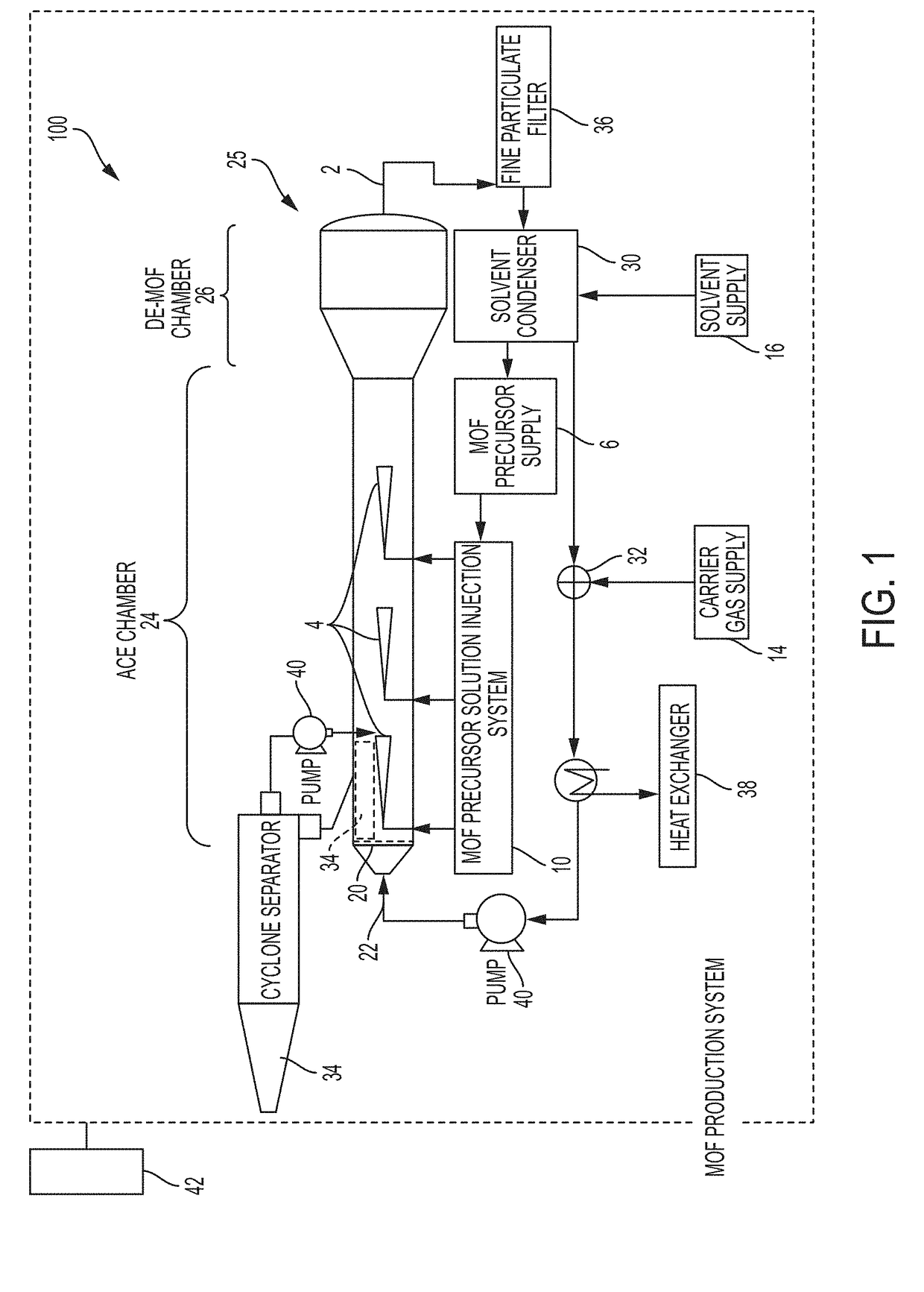System and process for continuous and controlled production of metal-organic frameworks and metal-organic framework composites
a technology of metalorganic frameworks and composites, which is applied in the field of metalorganic frameworks, can solve the problems of solvents that cannot be reused and replaced, nearly half of the total cost of a mof product presently, and the conventional batch synthesis of mofs is well-known and significant, and achieves effective and efficient mof products. , the effect of efficient scalable synthesis
- Summary
- Abstract
- Description
- Claims
- Application Information
AI Technical Summary
Benefits of technology
Problems solved by technology
Method used
Image
Examples
example 1
[0069]An exemplary pure MOF, Ni-MOF-74, was synthesized as follows. A MOF precursor solution was prepared by dissolving 30 mmol (e.g., 7.5 g) of a metal precursor containing nickel(II) acetate tetrahydrate in 100 mL water and sonicating for 3 minutes to form a clear solution. A second solution was prepared by mixing 15 mmol (e.g., 3 g) 2,5-dihydroxyterephthalic acid as an organic linker in 100 mL THF solvent and sonicated for 5 min to form a clear solution. The aqueous nickel acetate solution was mixed with THF solution in a [1:1] ratio and sonicated for 3 to 10 minutes to form a clear MOF precursor solution. The MOF production reactor was preheated to a temperature of between about 125° C. to about 150° C. The MOF precursor solution was then introduced into the MPR with a nitrogen carrier gas through a heated inlet at a flow rate of between about 0.05 scfm to 2.0 scfm to form a plume of aerosolized liquid droplets (e.g., of a nanometer size). Pressure in the MPR was less than or eq...
example 2
[0070]Pure metal MOFs including a cobalt metal MOF (Co-MOF-74); a zinc metal MOF (Zn-MOF-74); and a magnesium metal MOF (Mg-MOF-74) were produced using precursor solutions containing selected metal nitrates or metal acetates as the metal source and selected organic linkers listed in TABLE 1. MOF precursor solutions were introduced into MPR at a synthesis temperature of about 150° C. First run yield of the Co-MOF-74 (unoptimized) was 52%. Other pure MOFs listed in TABLE 1 were prepared using different solvents and molar ratios including, for example, IRMOF-3 at a synthesis temperature of 165° C. [first run yield, ˜45% (unoptimized)]; IRMOF-9 at a synthesis temperature of 165° C. [first run yield, 50% (unoptimized)]. Yields greater than 85% were typical. Greater yields may be obtained with further optimization. Other MOFs can be similarly produced including, for example, Mn-MOF-74, Fe-MOF-74, Ti-MOF-74, MOF-5, MOF-177, MOF-180, MOF-200, MOF-210, ZIF-8, TetZB, MOF-801, MOF-841, U10-66,...
example 3
[0071]A MOF precursor solution was prepared by dissolving a metal precursor of copper nitrate nonahydrate (2 mmol) in 100 mL DMF:ethanol:water in a [1:1:1] and sonicated for 3 minutes to form a clear solution. A second solution was prepared by mixing (1 mmol) benzene tricarboxylic acid as an organic linker in 100 mL DMF:ethanol:water in a [1:1:1] ratio and sonicated for 5 min to form a clear solution. Solutions were mixed and sonicated for 3 to 10 minutes to form a clear MOF precursor solution. The MOF production reactor was preheated to a temperature of between about 125° C. to about 160° C. MOF precursor solution was then introduced into the MPR with a nitrogen carrier gas through a heated inlet at a flow rate of between 0.05 scfm to 2.0 scfm to form a plume of aerosolized liquid droplets of a nanometer size. The process was continued until the desired particle size was reached. Size of resulting MOF particles was selected by controlling suspension of the MOF particles in the carr...
PUM
| Property | Measurement | Unit |
|---|---|---|
| size | aaaaa | aaaaa |
| temperatures | aaaaa | aaaaa |
| temperatures | aaaaa | aaaaa |
Abstract
Description
Claims
Application Information
 Login to View More
Login to View More - R&D
- Intellectual Property
- Life Sciences
- Materials
- Tech Scout
- Unparalleled Data Quality
- Higher Quality Content
- 60% Fewer Hallucinations
Browse by: Latest US Patents, China's latest patents, Technical Efficacy Thesaurus, Application Domain, Technology Topic, Popular Technical Reports.
© 2025 PatSnap. All rights reserved.Legal|Privacy policy|Modern Slavery Act Transparency Statement|Sitemap|About US| Contact US: help@patsnap.com



